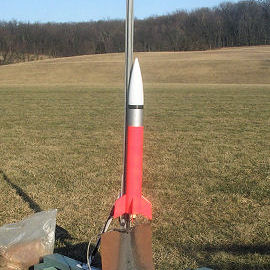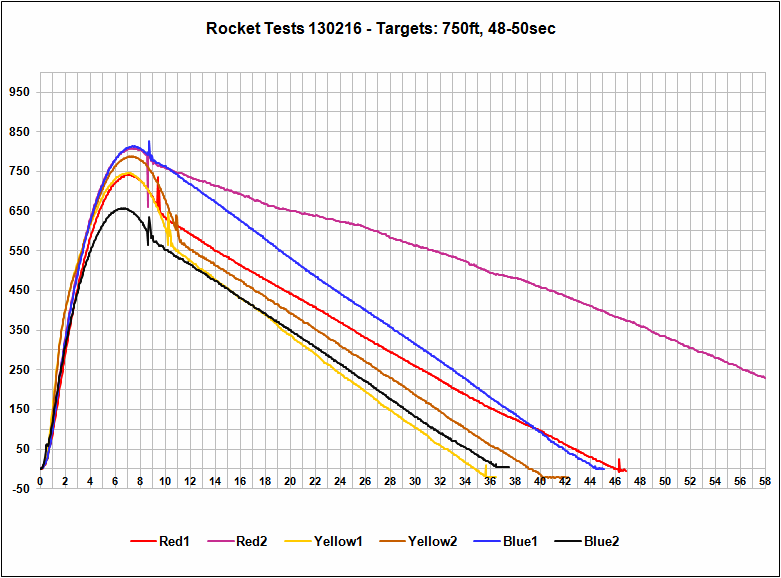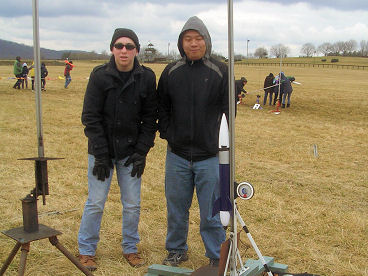|
|
Objectives
- Each team wanted to do one test launch and one qualifying launch.
Lessons
- Team 13255's red rocket with its low stability flew with the wind when the rail was
at 4 degrees and straight when we moved the angle to 2 degrees. While we tried to reduce the weight to
correct an under flight with the first launch, by correcting the angle, we over flew on the second
launch. We need to get back to a target weight of about 495g.and a straight launch.
- Teams 13254 and 13256 rockets with their higher stability flew into the wind and
could have used a greater launch angle.
- We had problems with the igniters spitting before they ignited the propellant. This
may have caused some altitude issues. We used the igniters that came with the package. On the final
lunch we used a copper head igniter and it also did not ignite smoothly. The issue may be a problem with
the White Lighting propellant. We might try some plugging or other igniters.
- The descent times were OK but not great, except for Team 13255's red rocket on it's
qualification launch. For some reason, it floated for ever. Most of our descents had the cargo
oscillating under the chute which causes air to spill out. In the one floater, there was no oscillation
and it just floated. The recommendation to reduce the oscillation is to increase the shroud length, but
then to limit the floating we need a small spill hole. We need a way to quantify this before we do
another qualification.
- All rockets were recovered, no eggs were broken, qualifications were valid.
- When weather conditions or field conditions are poor, we have trouble collecting all
the data we need to plan the next launch.
 On March 5, we went out to the Frederick Maryland launch site and conducted a single launch of Team 1326's orange rocket. We wanted to see if
it was stable design and possible for a qualification launch. We also wanted to see if we could reduce
descent rate by adding a 1.5in spill hole to the chute and extending the shroud lines with a single line of 18
inches. Here are the results. On March 5, we went out to the Frederick Maryland launch site and conducted a single launch of Team 1326's orange rocket. We wanted to see if
it was stable design and possible for a qualification launch. We also wanted to see if we could reduce
descent rate by adding a 1.5in spill hole to the chute and extending the shroud lines with a single line of 18
inches. Here are the results.
-
The rocket flew straight with no wiggle. At 383g it flew 758ft. The wind was under 5mph
and the rod was about 2degrees with the wind. See the
video. TARC score would have been 24.
-
The igniter again "spit" using the package's First-Fire Jr igniter.
-
The chute oscillated a little, but not as wild as before. The descent rate was
significantly lower. Flight duration was 54sec. See the chart of the altimeter data
and the raw data. We may want to try a slightly larger spill hole.
|
Launches
|
Rocket |
Engine |
Rail |
Cargo |
Cargo
Recovery |
Booster Recovery |
Weight |
Results |
Comments |
Red test 1
Team 13255
video |
E20-7W |
4d |
1 egg,
altimeter 2 |
15" Round |
6x60" Streamer |
390g
?g |
740ft, 47sec |
Flew with the wind |
Red test 2
Team 13255
video |
E20-7W |
2d |
1 egg,
altimeter 2 |
15" Round |
6x60" Streamer |
385g
?g |
807ft, 77sec |
Flew straight
Qualification Score: 165.00 |
Yellow test 1
Team 13254
no video |
E20-7W |
4d |
1 egg,
altimeter 1 |
15" Round |
6x60" Streamer |
370g
?g |
745ft, 36sec |
Flew into the wind, some wiggle |
Yellow test 2
Team 13254
video |
E20-7W |
4d |
1 egg,
altimeter 1 |
15" Round |
6x60" Streamer |
360g
?g |
787ft, 39.34sec |
Flew into the wind
Qualification Score: 71.64 |
Blue test 1
Team 13256
video |
E20-7W |
4d |
1 egg,
altimeter 3 |
15" Round |
6x60" Streamer |
378g
?g |
812ft, 45sec |
Flew into the wind. |
Blue test 2
Team 13256
video |
E20-7W |
4d |
1 egg,
altimeter 3 |
15" Round |
6x60" Streamer |
386g
?g |
656ft, 35.85sec |
Flew with the wind, unstable?
Qualification Score: 142.60 |
Altimeter Data
(Excel format)

Team 13255
Team 13256
 
|
|



